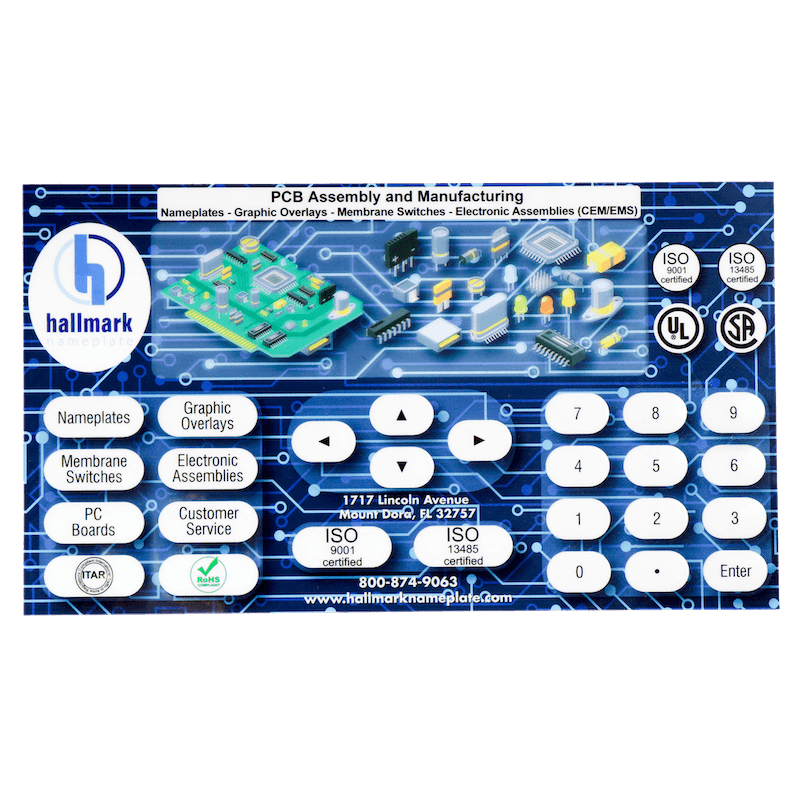Top Features to Look for in a High-Quality Membrane Switch
Top Features to Look for in a High-Quality Membrane Switch
Blog Article
Comprehending Membrane Layer Switches: The Trick to Resilient and Reliable Controls

What Are Membrane Layer Buttons?
Membrane switches are an advanced option in the world of interface innovation, incorporating capability and design perfectly. These gadgets act as an interface between individuals and electronic systems, incorporating a number of parts right into a compact format. Normally created from adaptable, slim layers of products, membrane buttons are created to reply to touch, making it possible for customers to connect with equipment and electronic devices effectively.
The primary elements of a membrane button include a printed circuit layer, visuals overlay, and a spacer layer that protects against unexpected activation. The graphic overlay can be tailored to reflect brand identification or customer choices, improving appearances while guaranteeing usability. Membrane layer buttons are frequently used in different applications, including clinical devices, consumer electronic devices, and commercial devices, owing to their sturdiness and resistance to environmental factors such as wetness and dirt.
Among the key benefits of membrane layer buttons is their capability to stand up to deterioration, making them perfect for high-traffic environments. In addition, they are lightweight and call for very little space, permitting cutting-edge styles in item development. On the whole, membrane layer switches stand for a useful and efficient option for contemporary electronic interfaces, marrying innovation with user-centric design concepts.
Exactly How Membrane Changes Job
The operation of membrane layer changes hinges on a straightforward yet effective system that translates individual input right into digital signals. These switches contain several layers, normally including a graphic overlay, a spacer layer, and a circuit layer. When an individual presses the switch, the top layer warps, enabling a conductive element in the circuit layer to make contact with a corresponding conductive pad on the bottom of the visuals overlay. This call shuts the circuit and sends out a digital signal to the device, showing that the switch has actually been triggered.
The design of membrane switches can differ, but they usually incorporate domes or tactile elements to give responses to the customer, enhancing the general experience - membrane switch. The products used in membrane switches, such as polyester or polycarbonate, contribute to their durability and resistance to environmental factors, consisting of dampness and dirt. In addition, the published circuits are usually enveloped, which safeguards them from deterioration in time.
Benefits of Membrane Layer Buttons

Additionally, membrane switches are recognized for their longevity. Created from durable products, they are resistant to dirt, dampness, and physical wear, which considerably prolongs their lifespan contrasted to conventional mechanical buttons. This sturdiness makes them specifically appropriate for high-traffic environments and applications needing durability.
One more considerable benefit is the ease of cleansing and upkeep. The smooth surface of membrane changes lessens dust buildup and is usually invulnerable to spills, making them ideal for settings that require frequent sanitization.
Additionally, membrane layer buttons supply a structured account, causing a thinner style that can be incorporated my blog right into numerous tools without including mass. This function not just enhances the visual allure however also address adds to a more ergonomic product layout.
Applications of Membrane Layer Buttons
User-friendly and versatile, membrane layer buttons discover applications across a variety of markets, including clinical tools, consumer electronics, and commercial equipment. In the clinical field, these switches are indispensable to gadgets such as diagnostic tools, person surveillance systems, and mixture pumps, where integrity and convenience of cleansing are critical. Their ability to preserve and withstand extreme environments functionality makes them suitable for such applications.

In consumer electronic devices, membrane buttons are utilized in items like microwaves, cleaning devices, and remotes - membrane switch. Their smooth layout enables intuitive interface, enhancing the total customer experience while providing durability and resistance to tear and put on
Industrial devices likewise benefits from membrane switches, especially in control panels for machinery and automation systems. These buttons offer protection versus dirt and moisture, ensuring regular performance in difficult environments. In addition, their customizable attributes permit suppliers to customize them to certain functional requirements, enhancing efficiency and functionality.
Selecting the Right Membrane Layer Switch Over
When picking a membrane layer button, it is crucial to think about various factors that influence efficiency and suitability for specific applications. The main factors to consider include environmental conditions, tactile comments, sturdiness, and layout requirements.
First, evaluate the operating setting; switches exposed to wetness, click here now chemicals, or extreme temperatures call for details materials to make certain long life and functionality. Next off, assess the need for responsive comments. Relying on user communication, some applications may take advantage of a tactile response to verify activation, while others might like a non-tactile design for visual factors.
Sturdiness is an additional essential variable; membrane switches should be made to hold up against frequent use, effects, and abrasion. Guarantee the picked button can withstand the anticipated lifecycle, especially in high-usage situations.

Verdict
In conclusion, membrane changes offer as essential elements in the layout of long lasting and dependable control systems across various industries. The adaptability of membrane layer switches permits for customized services that fulfill certain operational needs, enhancing their importance in contemporary technology.
Membrane switches represent a critical element of modern user interface layout, blending performance with durability in various applications.Membrane layer switches are a sophisticated service in the realm of user interface technology, incorporating functionality and design perfectly. Typically created from versatile, thin layers of materials, membrane buttons are designed to respond to touch, allowing customers to interact with machinery and electronic devices successfully.
The layout of membrane switches can differ, but they typically include domes or responsive elements to supply feedback to the user, enhancing the total experience.In verdict, membrane switches offer as important components in the design of dependable and resilient control systems throughout numerous markets.
Report this page